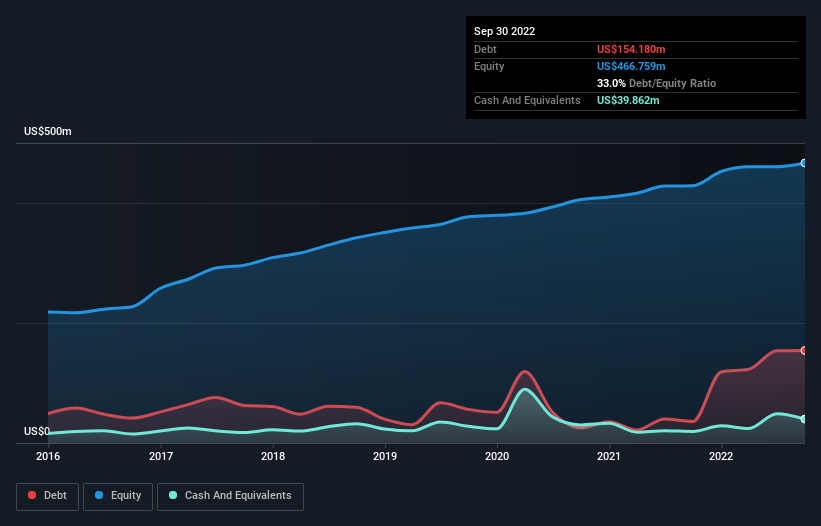- United States
- /
- Healthcare Services
- /
- NYSE:USPH
We Think U.S. Physical Therapy (NYSE:USPH) Can Stay On Top Of Its Debt

Legendary fund manager Li Lu (who Charlie Munger backed) once said, 'The biggest investment risk is not the volatility of prices, but whether you will suffer a permanent loss of capital.' When we think about how risky a company is, we always like to look at its use of debt, since debt overload can lead to ruin. We note that U.S. Physical Therapy, Inc. (NYSE:USPH) does have debt on its balance sheet. But is this debt a concern to shareholders?
What Risk Does Debt Bring?
Debt is a tool to help businesses grow, but if a business is incapable of paying off its lenders, then it exists at their mercy. In the worst case scenario, a company can go bankrupt if it cannot pay its creditors. However, a more frequent (but still costly) occurrence is where a company must issue shares at bargain-basement prices, permanently diluting shareholders, just to shore up its balance sheet. Having said that, the most common situation is where a company manages its debt reasonably well - and to its own advantage. When we examine debt levels, we first consider both cash and debt levels, together.
Check out our latest analysis for U.S. Physical Therapy
How Much Debt Does U.S. Physical Therapy Carry?
You can click the graphic below for the historical numbers, but it shows that as of September 2022 U.S. Physical Therapy had US$154.2m of debt, an increase on US$35.9m, over one year. However, it also had US$39.9m in cash, and so its net debt is US$114.3m.

How Strong Is U.S. Physical Therapy's Balance Sheet?
The latest balance sheet data shows that U.S. Physical Therapy had liabilities of US$81.5m due within a year, and liabilities of US$251.5m falling due after that. On the other hand, it had cash of US$39.9m and US$68.9m worth of receivables due within a year. So its liabilities total US$224.2m more than the combination of its cash and short-term receivables.
This deficit isn't so bad because U.S. Physical Therapy is worth US$1.05b, and thus could probably raise enough capital to shore up its balance sheet, if the need arose. But it's clear that we should definitely closely examine whether it can manage its debt without dilution.
We measure a company's debt load relative to its earnings power by looking at its net debt divided by its earnings before interest, tax, depreciation, and amortization (EBITDA) and by calculating how easily its earnings before interest and tax (EBIT) cover its interest expense (interest cover). This way, we consider both the absolute quantum of the debt, as well as the interest rates paid on it.
U.S. Physical Therapy's net debt is only 1.4 times its EBITDA. And its EBIT easily covers its interest expense, being 22.9 times the size. So you could argue it is no more threatened by its debt than an elephant is by a mouse. On the other hand, U.S. Physical Therapy saw its EBIT drop by 8.1% in the last twelve months. That sort of decline, if sustained, will obviously make debt harder to handle. The balance sheet is clearly the area to focus on when you are analysing debt. But ultimately the future profitability of the business will decide if U.S. Physical Therapy can strengthen its balance sheet over time. So if you're focused on the future you can check out this free report showing analyst profit forecasts.
But our final consideration is also important, because a company cannot pay debt with paper profits; it needs cold hard cash. So we always check how much of that EBIT is translated into free cash flow. Happily for any shareholders, U.S. Physical Therapy actually produced more free cash flow than EBIT over the last three years. That sort of strong cash conversion gets us as excited as the crowd when the beat drops at a Daft Punk concert.
Our View
Happily, U.S. Physical Therapy's impressive interest cover implies it has the upper hand on its debt. But truth be told we feel its EBIT growth rate does undermine this impression a bit. We would also note that Healthcare industry companies like U.S. Physical Therapy commonly do use debt without problems. Taking all this data into account, it seems to us that U.S. Physical Therapy takes a pretty sensible approach to debt. That means they are taking on a bit more risk, in the hope of boosting shareholder returns. The balance sheet is clearly the area to focus on when you are analysing debt. But ultimately, every company can contain risks that exist outside of the balance sheet. For example - U.S. Physical Therapy has 2 warning signs we think you should be aware of.
If, after all that, you're more interested in a fast growing company with a rock-solid balance sheet, then check out our list of net cash growth stocks without delay.
New: AI Stock Screener & Alerts
Our new AI Stock Screener scans the market every day to uncover opportunities.
• Dividend Powerhouses (3%+ Yield)
• Undervalued Small Caps with Insider Buying
• High growth Tech and AI Companies
Or build your own from over 50 metrics.
Have feedback on this article? Concerned about the content? Get in touch with us directly. Alternatively, email editorial-team (at) simplywallst.com.
This article by Simply Wall St is general in nature. We provide commentary based on historical data and analyst forecasts only using an unbiased methodology and our articles are not intended to be financial advice. It does not constitute a recommendation to buy or sell any stock, and does not take account of your objectives, or your financial situation. We aim to bring you long-term focused analysis driven by fundamental data. Note that our analysis may not factor in the latest price-sensitive company announcements or qualitative material. Simply Wall St has no position in any stocks mentioned.
About NYSE:USPH
Reasonable growth potential with adequate balance sheet.
Similar Companies
Market Insights
Community Narratives



